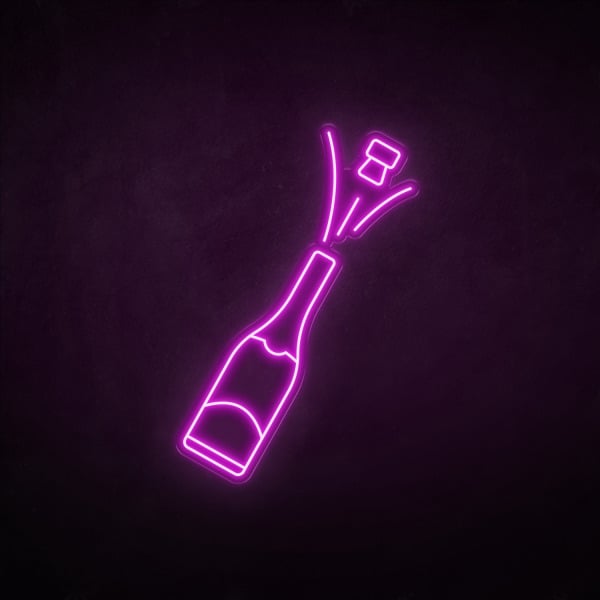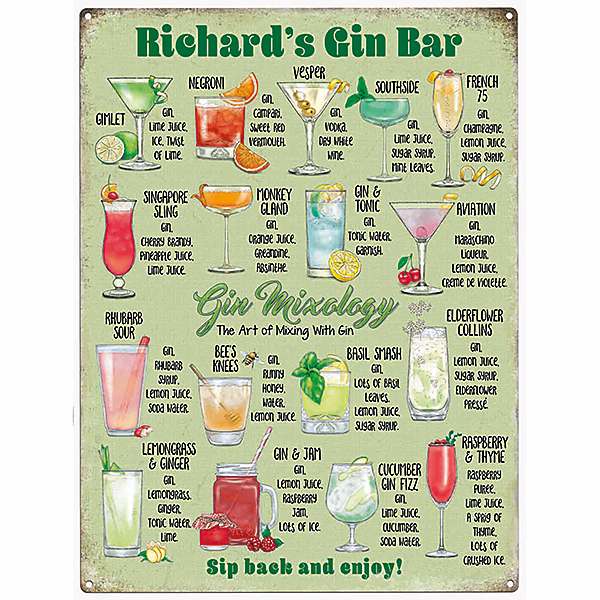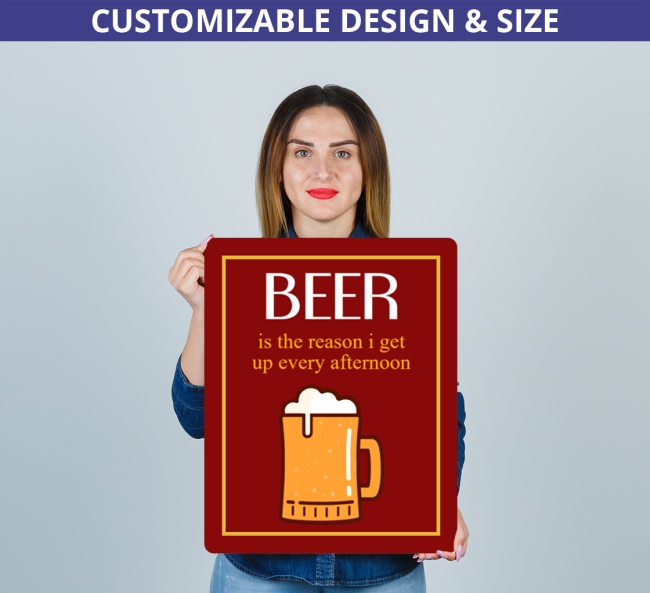Good Suggestions For Choosing Gin Bar Signs
What Is The Difference Between Bar Signs In Terms Of Size?Bar signs vary in size and style based on their intended purpose, placement and overall aesthetic. This is why the different dimensions impact bar sign's functionality and appeal. Large Signs
The function of an Arrow is to draw attention and function as a focal-point.
Uses : Exterior signage or primary branding signs.
Placement: They are typically installed on walls or larger surfaces outside of the bar, to attract customers.
Examples include large neon signs such as vintage-style signs or mural signs.
2. Medium Signs
Use to display information or to enhance the decor of a space without dominating it.
Uses include menu boards, as well as directions and displays for promotions.
Placement: Positioned to be easily seen but not overpowering.
For instance chalkboards of medium size with daily specials or signs made of metal that feature the bar's logo.
3. Small Signs
Useful: To add delicate decorative elements or offer specific details.
Uses for table signs, decorative pieces or labels.
Placement: Tables, shelves or displays that permit close-up views.
For example, table number signs, tiny framed quotes, or drink menus.
Size Factors
Visibility
Large Signs: They are designed to be visible from a distance, which makes the perfect choice for attracting people as well as establishing the bar's popularity.
Medium signs balance visibility and space efficiency to provide vital information without overpowering the décor.
Small Signs (small signs) They are perfect for information that is intimate and close-up, which can be displayed at eye-level.
Proportion
To keep smaller spaces from being overwhelmed Large signs must be proportional to the dimensions of the area. The ideal choice for large or open environments.
Medium Signs: Suitable for most interior spaces and offers versatility in placement.
Small signs are ideal to provide more detail and be tucked away in smaller spaces.
Impact
Signs that are large can create an impressive statement. they are also used to create a brand. Often employed to set the tone for the bar.
Medium Signs: Strikes the perfect balance between visibility and décor and adds to the overall mood while conveying important information.
Small signs: add interest and detail which create a better visual experience.
Practicality
Large Signs (Large) These signs require substantial mounting options and are often more costly because of their size.
Medium Signs are easy to put up, move and offer flexibility with design changes.
Small Signs: Highly versatile and simple to update or replace, ideal for dynamic environments such as bars that have constantly changing menus or specials.
Functionality
Large Signs: Mostly for visibility and attraction.
Medium Signs: They're both functional and decorative. They offer vital information, but also enhance the aesthetics.
Small Signs: Created to provide precise information and contribute to the theme in a subtle way.
The proper size of an appropriate bar sign is dependent on its intended purpose, the layout of space and the effect that is desired by the patrons. The signs can contribute to the atmosphere and operation of the bar when they are well-balanced. Read the top click here for more tips including home pub signs, outdoor home bar signs, bar sign hanging, sign for garden bar, novelty bar signs, garden pub signs, large bar signs, garden bar signs, personalised outdoor pub signs, home made bar sign and more.

What Are The Distinctions Between Bar Signs With Regard To Lighting?
Bar signs vary in their lighting. This affects lighting, atmosphere and the impact. Here are the main ways in which lighting variations influence bar signs:1. Neon Signs
Characteristics: Bright, colorful, classic.
Lighting: Make use of gas tubes with neon-filled gas that emit illumination when they are electrically charged.
Uses : Great for creating a vintage, retro look. Used for logos and bar names.
Advantages: Visible even from a distance, and it has a nostalgic appeal.
Inconveniences: The product is fragile and repairs can be costly.
2. LED Signs
Characteristics: Energy-efficient, versatile, modern.
Lighting: Utilizes light emitting diodes (LEDs) to create glowing and bright light.
Applications: It can be used for outdoor or indoor signs, and also programmable displays.
Benefits: The LEDs are durable, energy efficient, and can be programmed to show colors or animations.
Advantages: Initial cost can be high, but savings on energy and maintenance are significant.
3. Backlit Signs
Characteristics: Elegant, sophisticated, subtle.
Lighting: Place LEDs and fluorescent lighting behind translucent surfaces to produce soft diffused light.
Uses include modern bars and menu boards.
Advantages: Professional and clean appearance, enhances readability even in low lighting.
The disadvantages are more complex installation procedure and more expensive upfront.
4. Signs that Edge-Lit
Characteristics: Sleek, contemporary, stylish.
Lighting: LEDs are employed to light the edges of acrylic sign panels.
Uses for: Modern design, minimalist.
Advantages Gives a refined and distinct look.
Disadvantages
5. Ambient/Accent Lighting
Characteristics: Subtle, atmospheric, decorative.
Lighting: Uses indirect light sources to enhance and highlight the signage.
Uses Increases the mood. Often used to highlight artwork or themed décor.
Benefits: Creates a warm and welcoming environment.
Negatives: Direct lighting may not be enough to read.
6. Marquee signs
Characteristics: Bold, theatrical, eye-catching.
Lighting Lights: Multiple LEDs or light bulbs are utilized around the sign's edges.
Applications : Popular for creating vintage film looks and exterior signs.
Attractive and well-lit.
Disadvantages include: High cost and regular maintenance.
7. Projection Signs
Characteristics: Dynamic, innovative, versatile.
Lighting: Uses projectors to cast images and light onto the surface.
Uses: Ideal for promotional events, temporary displays, and other displays that are dynamic.
Advantages: Easy to change No physical structure needed.
Negatives
8. Fluorescent Signs
Characteristics: Bright, cost-effective, traditional.
Lighting Tubes that emit light for lighting.
Usage: Most often used for large indoor and outdoor signage.
Benefits: Effective and bright for large signage. It is relatively inexpensive.
Cons: Not as energy efficient LEDs. They can be more harsh in their light.
Lighting Things to Consider
Visibility
Neon Signs and LED signs: These are great for grabbing attention, especially at night.
Backlit or edge-lit Signs can be great for making your signs more readable, and to create an attractive and professional look.
Energy Efficiency
LED Signs: Highly energy-efficient and long-lasting.
Neon and fluorescent signs The reason for this is that neon is not as efficient in energy use.
Aesthetic Appeal
Neon and marquee signs: ideal for vintage and retro aesthetics.
Edge-lit and backlit signs Ideal for clean, modern designs.
Ambient lighting enhances overall atmosphere.
Maintenance
LED Signs - Low Maintenance and Durable
Neon and Fluorescent signs require frequent maintenance and repair.
Cost
LED and Backlit Signs: Higher upfront costs but lower operational costs.
Fluorescent signs: lower initial cost, but more expensive energy over the long term.
Flexibility
The flexibility of LED signage and projections allows for dynamic and changing content.
Traditional signs are more rigid however they give the desired appearance.
Select the appropriate type of lighting for your bar signage to improve visibility, create an inviting ambience, and effectively convey your brand and promotions. Take a look at the top discover more on garden bar signs for website examples including indoor bar signs, hanging home bar signs, hanging pub signs personalised, pub signs to buy, personalised pub signs for garden, personalised home pub sign, large pub sign, personalised pub signs for garden, outdoor home bar signs, hanging pub signs for sale and more.

What Is The Difference Between Bar Signs In The Sense Of Branding
Bar signs play a crucial role in branding. They convey to clients the company's personality, style and the identity of the business. What are the distinctions between logos and bar signs? Logo and branding identity
Logo Integration: Placing the logo of a bar prominently on signage will establish an image and boost the reputation of the establishment.
Consistent branding - Signs must be synchronized with other branding elements, such as coasters or menus, as well as social media profiles, in order to maintain uniformity.
2. Visual Style Design
Thematic design: Signs are designed to represent the theme or the atmosphere of a bar.
Custom Graphics. Unique typography and graphics can be used to identify your brand. They also draw attention.
3. Color Scheme
Branded Colors. Utilizing a bar's brand colors on the signage can help reinforce the brand and create a cohesive identity.
Colors that are legible and contrasty: They were selected are not just for branding consistency however, they are also selected for their the ability to read and be seen under various lighting conditions.
4. Tone and Communication
Brand Voice: The signs communicate the bar's personality and tone through messaging, whether it's fun and lighthearted, elegant and sophisticated, or even striking and edgy.
Slogans and taglines The use of catchy slogans or taglines can help reinforce the brand's message and create a lasting impact on customers.
5. Visibility and Placement
Signage Placement: Signage is strategically placed near the entrance of the venue, on the back of the bar, or throughout the entire space.
Size and Scale. Larger signs grab attention and stand out with bold assertions, while smaller signs offer subtle branding cues for more intimate spaces.
6. Specialty Signage
Signature Signs: Customized signage, such as chalkboard menus or neon signage, can give a unique and personal touch to a bar as well as enhancing the brand's identity.
Interactive elements: Signs that feature interactive elements such as QR codes and digital menus that engage customers, enhance their experience, and promote brand recognition.
7. Brand Storytelling
Signs that feature historical features like the place of the bar or the founder could make a connection and a sense of authenticity among customers.
Unique Selling Points: Highlighting exclusive drinks, special offers, or unique amenities in signs reinforces the bar's value offering and attracts customers.
8. Promotional branding and seasonal branding
Holiday themes. The decor of the season and the themed signs reflect the bar's festive atmosphere and provide the perfect experience for the customers.
Advertising that promotes special occasions like happy hour or deals that are limited-time can boost sales.
9. Customer Engagement
User-generated content: Ask patrons to post photos of their signs on social media platforms. This will increase the brand's visibility and create a community atmosphere in the bar.
Interactive Signage - Signs that encourage patron participation, like chalkboard walls for drawing and photo booths to take selfies. These signs provide memorable brand experiences.
10. Digital Branding
Digital Signage. Interactive displays or LED screens can be utilized to create dynamic branding providing real-time updates to content, animations and multimedia.
Online Presence QR Codes and Social Media handles that are displayed on Signage increase online engagement and connect patrons to the bar's online presence. This improves brand visibility and accessibility.
With the use of signage as a marketing tool bar owners are able to effectively communicate their brand's image, engage customers, and differentiate their establishment from a competitive market. Follow the top on front page on bar sign hanging for website info including pub signs personalised, large bar signs, personalised pub signs for garden, personalised hanging bar sign, a bar sign, personalised pub signs for garden, garden bar signs, large pub sign, hanging pub signs for garden, garden bar sign personalised and more.
